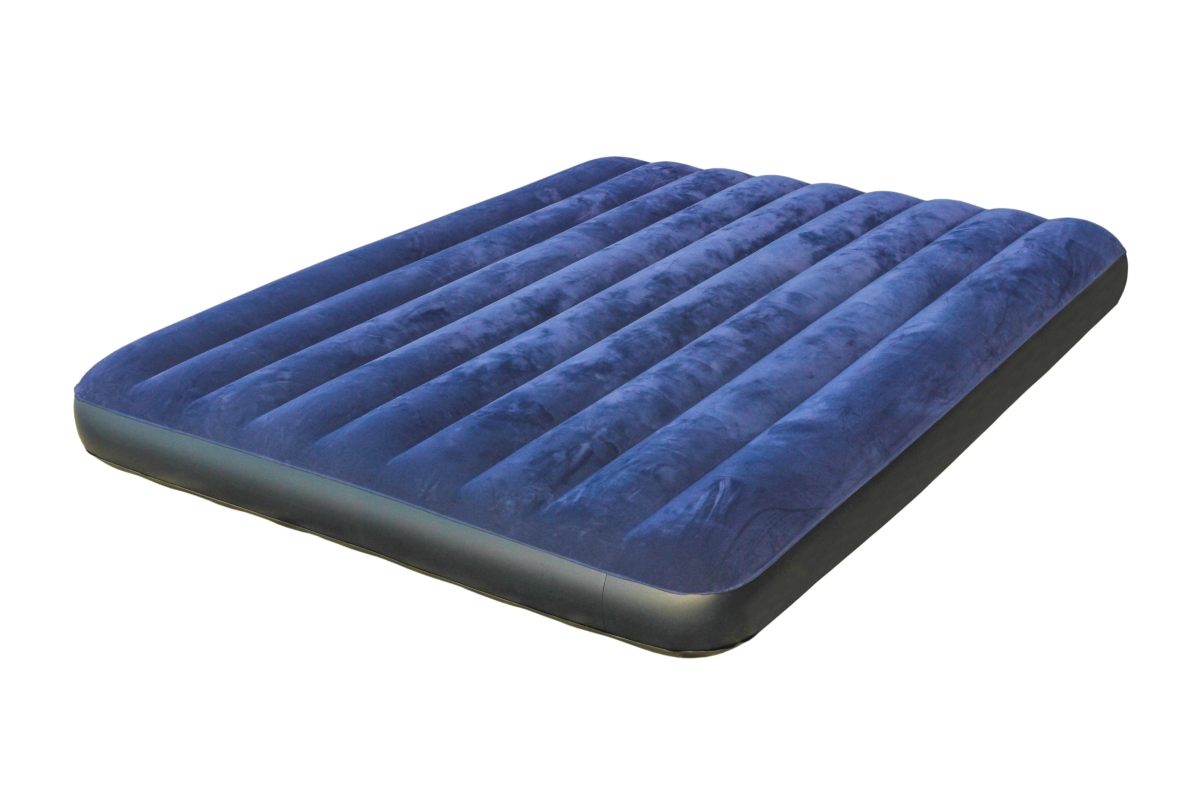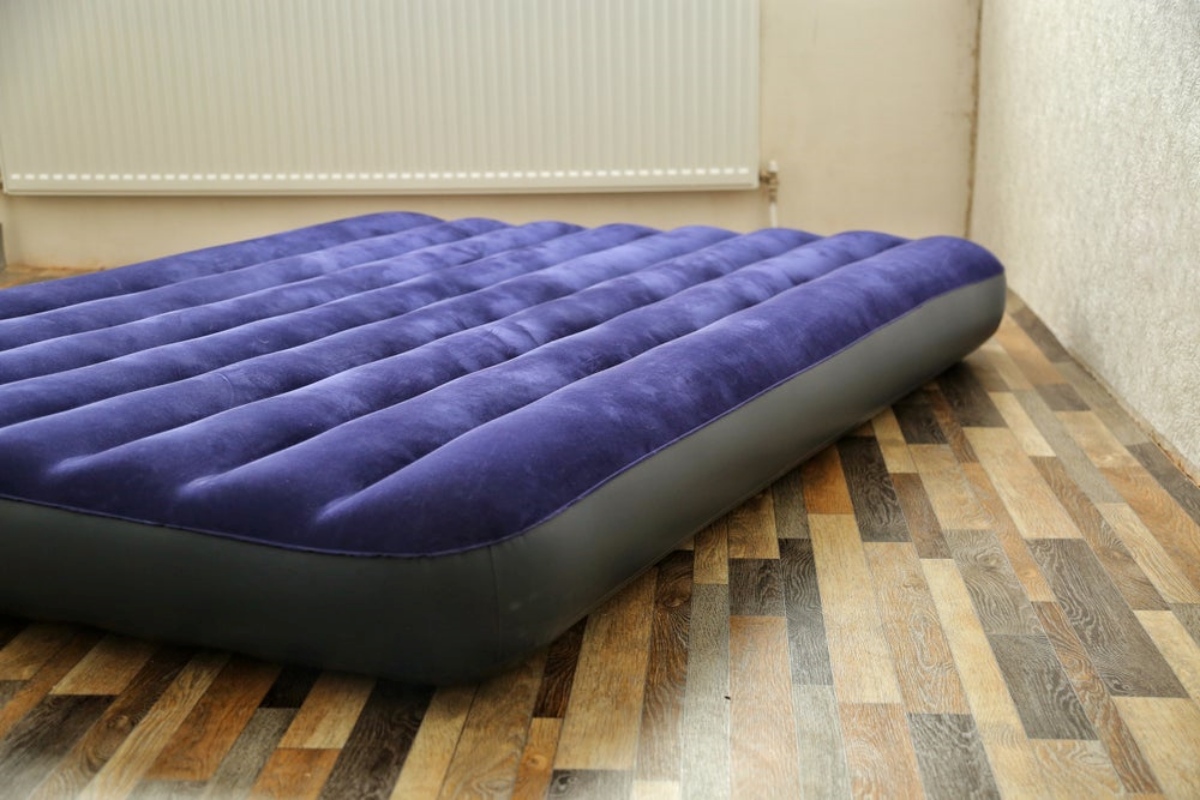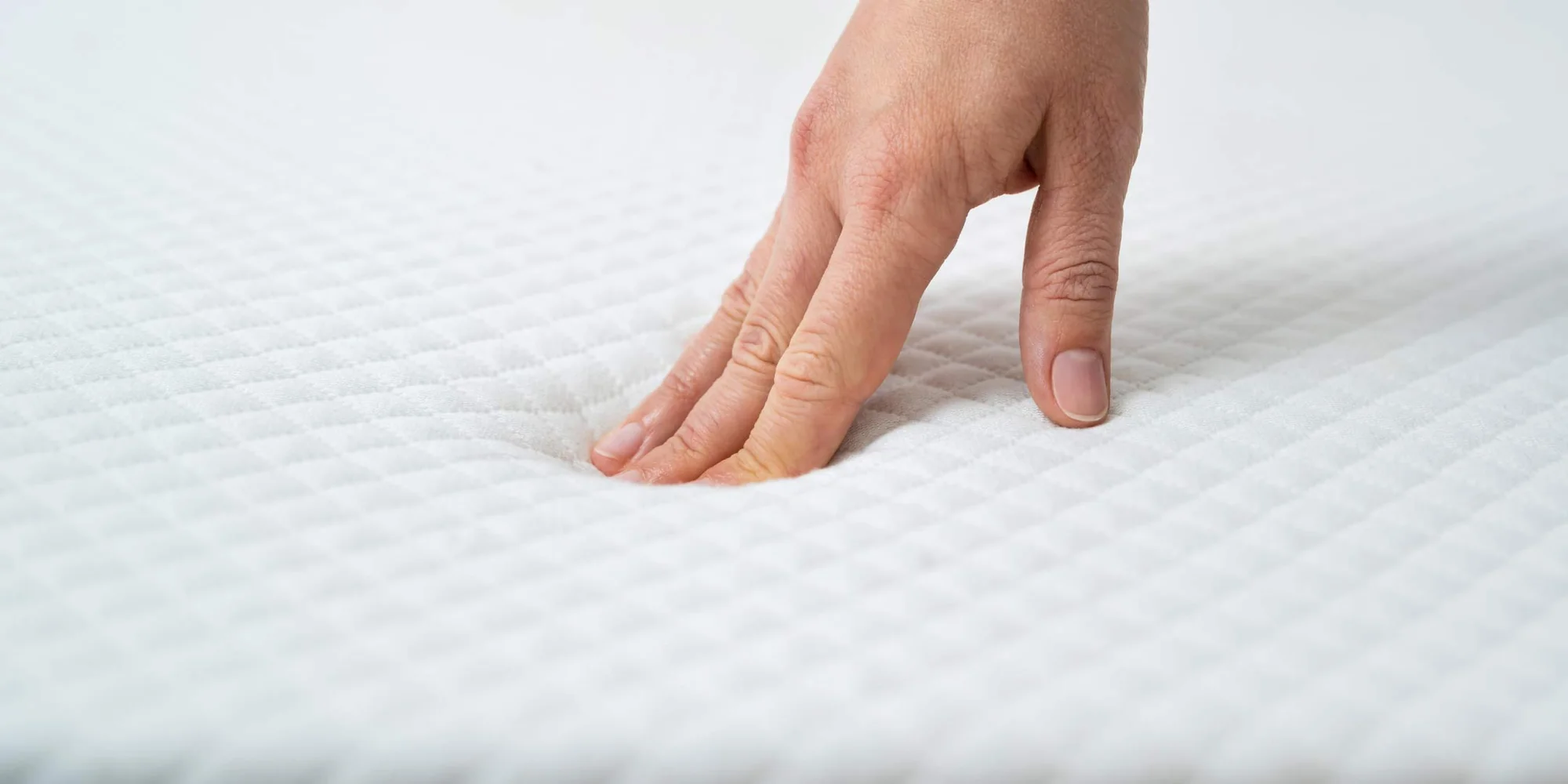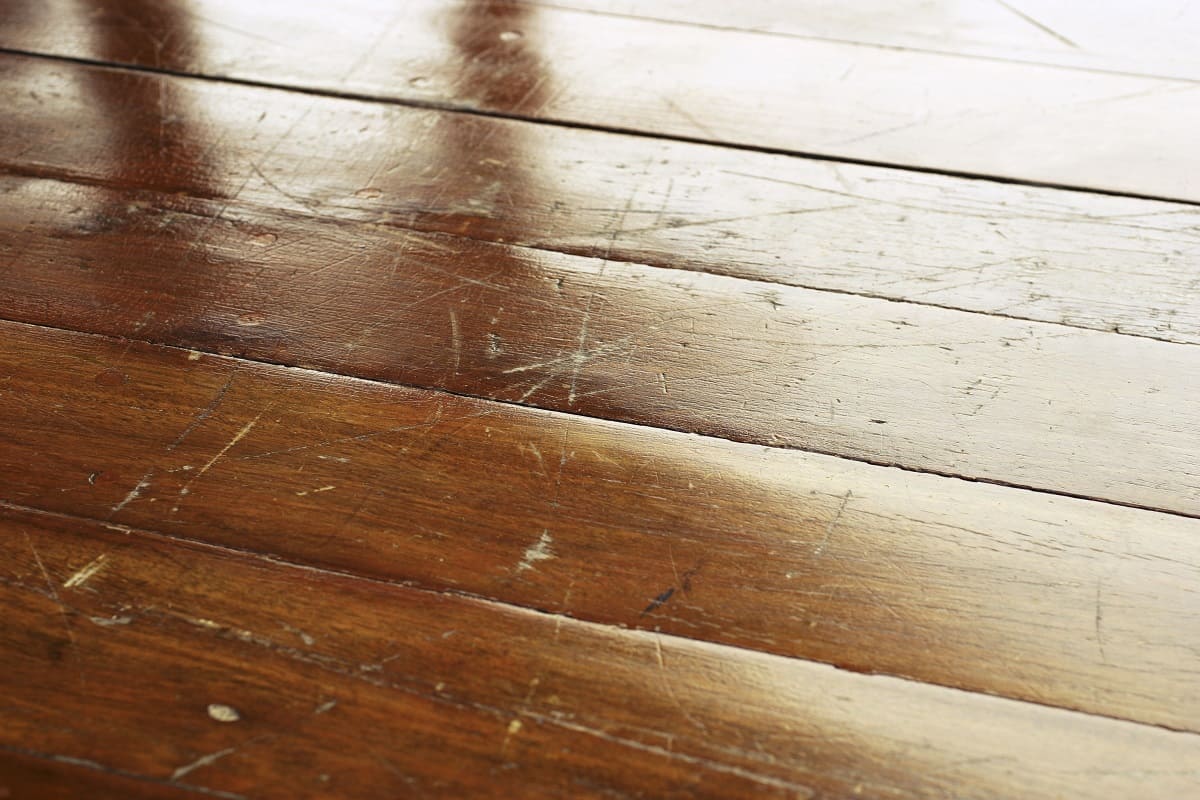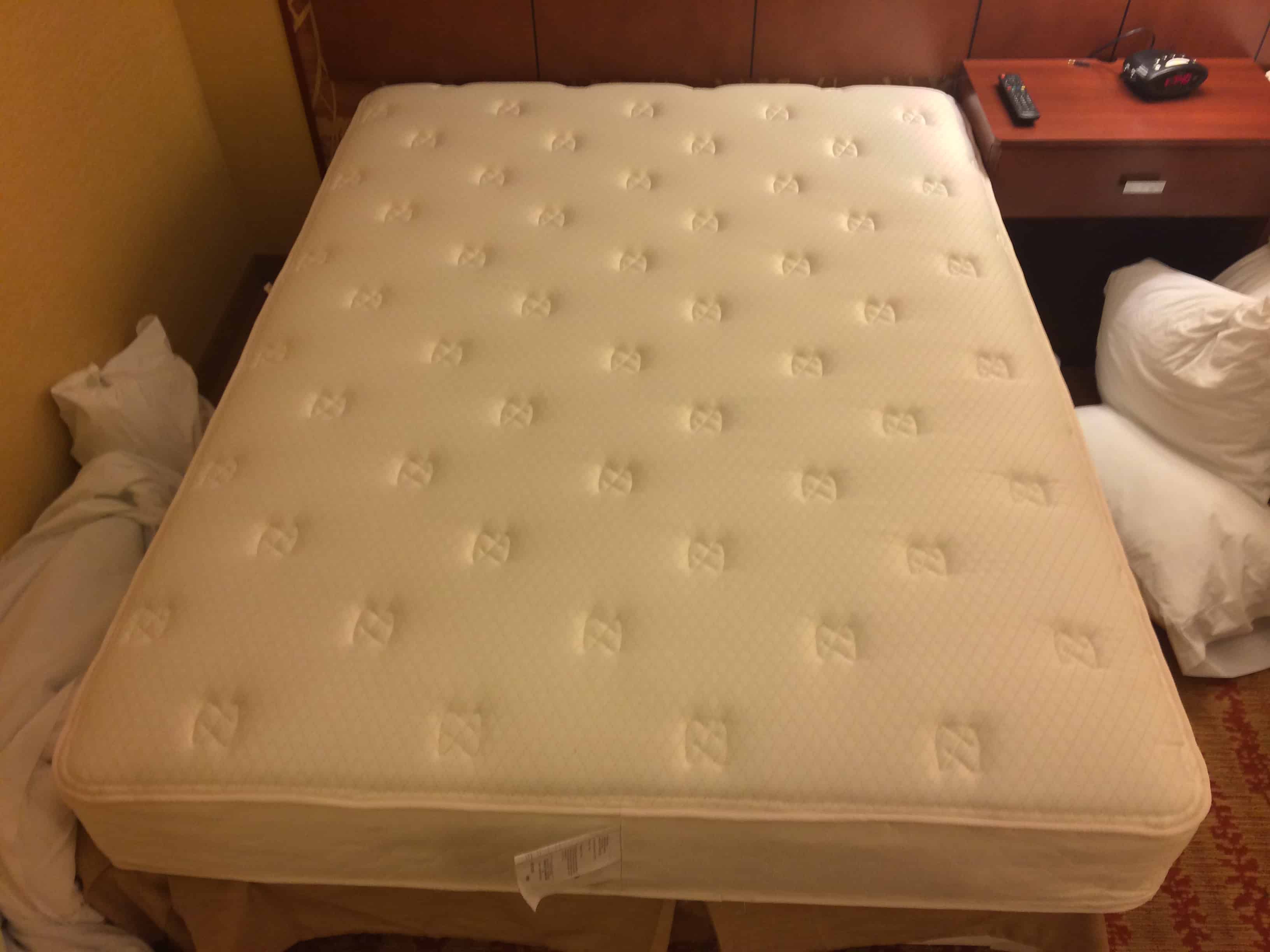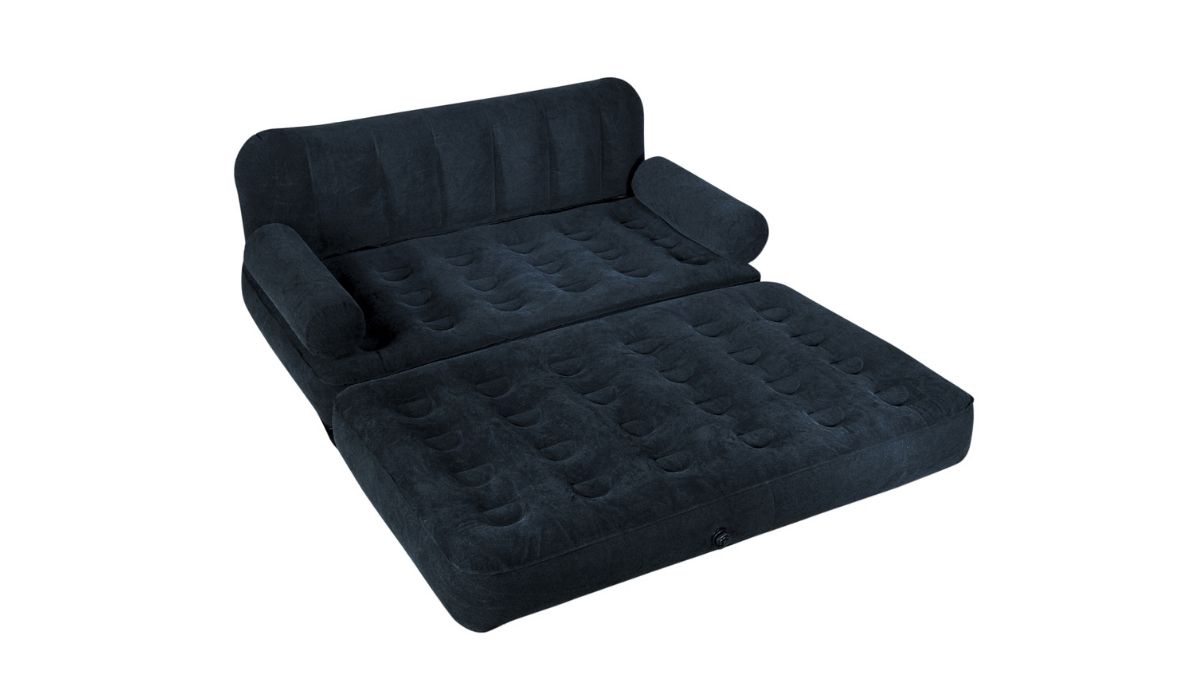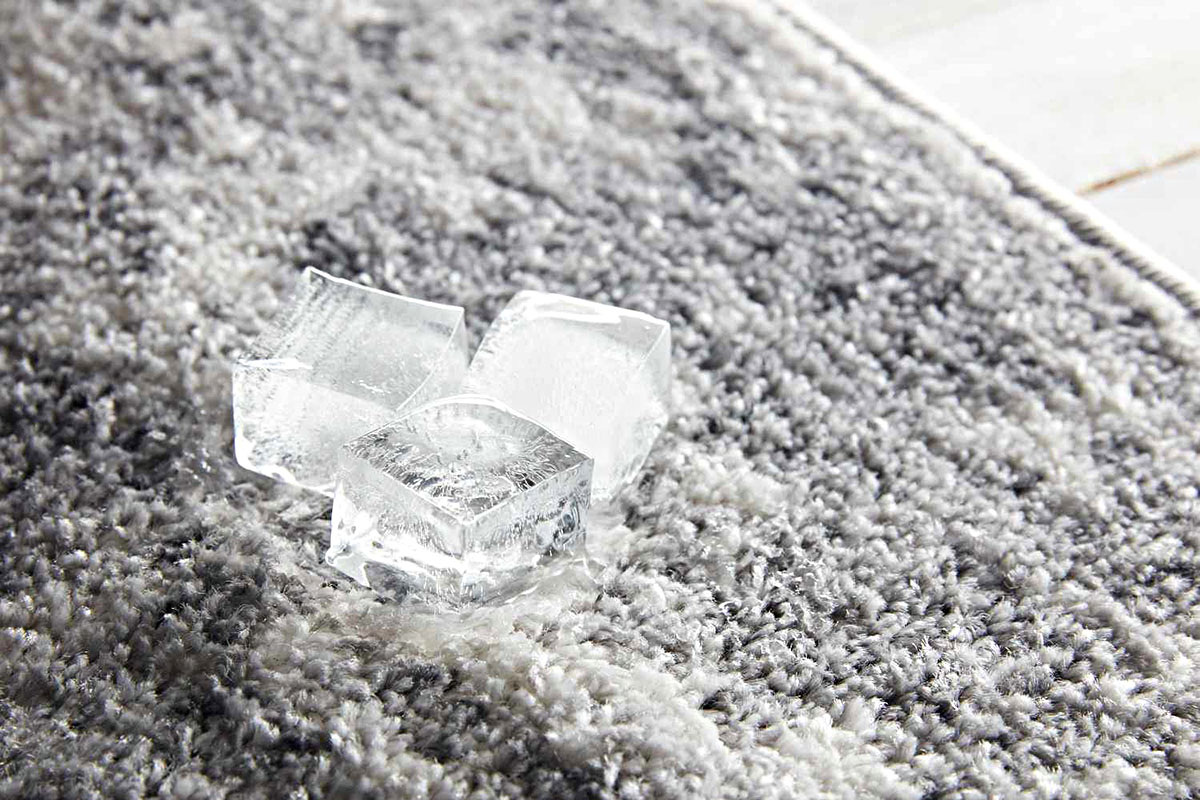Home>Furniture>Bedroom Furniture>Why Is There A Dent In My Mattress
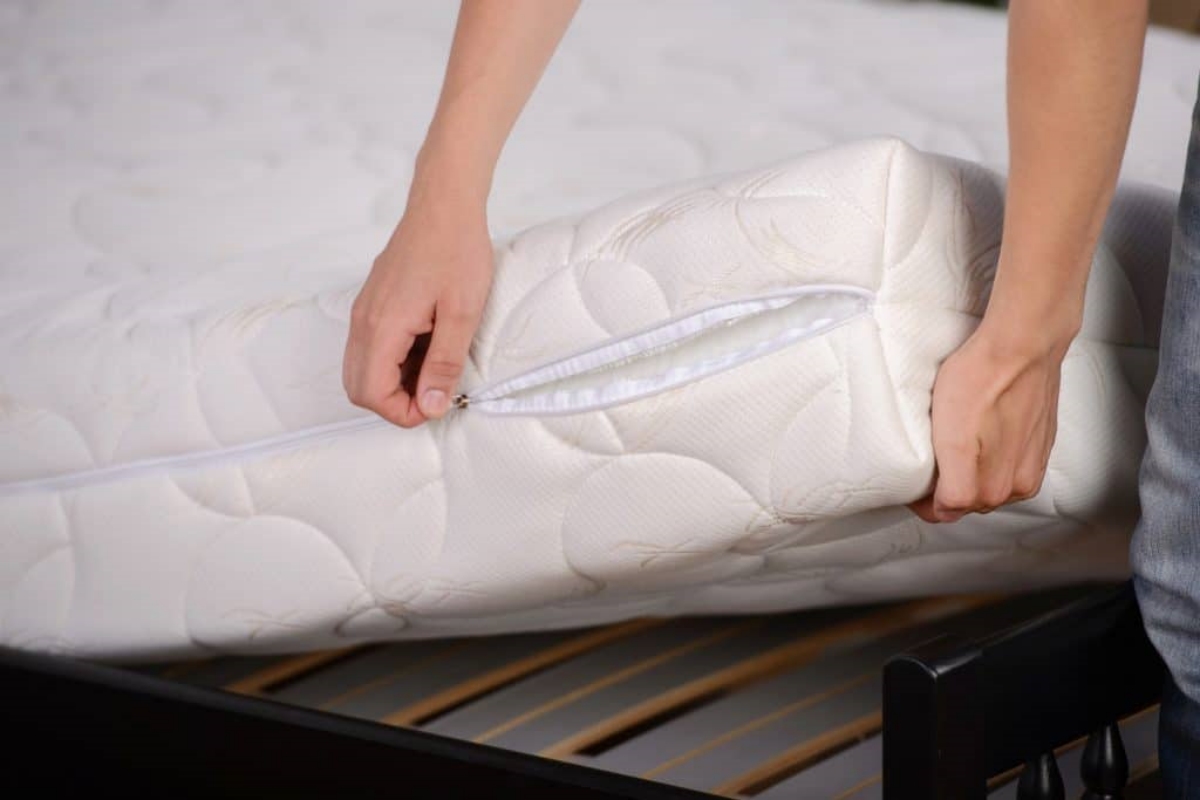

Bedroom Furniture
Why Is There A Dent In My Mattress
Modified: October 20, 2024
Discover why there's a dent in your mattress and how to fix it. Explore our range of high-quality bedroom furniture for a comfortable and supportive sleep.
(Many of the links in this article redirect to a specific reviewed product. Your purchase of these products through affiliate links helps to generate commission for Storables.com, at no extra cost. Learn more)
Introduction
Have you ever woken up in the morning to find an unsightly dent in your mattress? It can be quite frustrating and uncomfortable, especially if you paid a significant amount of money for a high-quality mattress. While mattress dents are a common issue, understanding the causes and finding ways to prevent and fix them can help prolong the lifespan of your mattress and ensure a restful night’s sleep.
In this article, we will explore the common causes of a dent in your mattress and provide practical tips on how to prevent and fix these pesky indentations. By following these guidelines, you can maintain the integrity and comfort of your mattress, ensuring a perfect oasis for a good night’s sleep.
Key Takeaways:
- Prevent mattress dents by rotating, using high-quality materials, and avoiding concentrated weight. Regular care and maintenance can extend the lifespan of your mattress, ensuring a comfortable and supportive sleep surface.
- If faced with a dent, try re-firming the mattress or using a topper. Consult the manufacturer or consider replacement if the dent persists. Prioritize a high-quality mattress for better sleep quality.
Read more: Why Is My Mattress Brown
Common Causes of a Dent in Your Mattress
There are several factors that can contribute to the formation of a dent in your mattress. Understanding these causes will help you take proactive measures to prevent them. Here are the common culprits:
- Body Impressions: Over time, your mattress can develop body impressions, which are natural contours that form as you sleep on the same spot night after night. This can lead to uneven surface areas and eventually cause a dent in the mattress.
- Low-Quality Materials: Mattresses made from low-density foam or inferior materials may be prone to developing dents more quickly. These materials do not have the durability or resilience to withstand prolonged use and pressure.
- Improper Care and Maintenance: Not properly caring for your mattress can also contribute to dent formation. Failure to regularly rotate and flip your mattress can cause uneven wear, leading to dents in specific areas.
- Overloading the Mattress: Mattresses have weight limits, and overloading them with excessive weight can cause them to sag and develop dents. This is particularly true if you place heavy items on the same spot repeatedly.
- Manufacturing Defects: In some cases, a dent may be the result of a manufacturing defect. This can include issues with the internal structure or materials of the mattress that can cause premature indentation.
Now that you are aware of the common causes of mattress dents, let’s explore practical steps you can take to prevent them in the first place.
Body Impressions
Body impressions are a natural occurrence in mattresses. As you sleep, your body puts pressure on certain areas of the mattress, causing the materials to compress and form impressions. Over time, these impressions can become more pronounced and lead to the formation of a dent.
To prevent body impressions from becoming permanent dents, it is important to regularly rotate and flip your mattress. By rotating your mattress from head to foot and flipping it upside down, you can distribute the weight and pressure evenly, allowing the materials to recover and regain their original shape.
For memory foam mattresses, consider using a mattress topper or pad with good pressure relief properties. This extra layer of cushioning can help distribute your body weight more evenly and minimize the formation of deep impressions.
Additionally, investing in a high-quality mattress that is designed to resist body impressions can significantly reduce the risk of dents. Look for mattresses with durable materials and advanced support systems that are specifically engineered to withstand the effects of body weight and pressure over time.
Remember, prevention is key when it comes to body impressions and mattress dents. By implementing these proactive measures, you can extend the lifespan of your mattress and enjoy a comfortable and supportive sleep surface for years to come.
Low-Quality Materials
The quality of the materials used in a mattress plays a significant role in its durability and resistance to dents. Mattresses made from low-quality materials, such as low-density foam or inferior spring systems, are more likely to develop dents and lose their shape over time.
Low-density foam lacks the resilience and durability needed to withstand prolonged use and pressure. It tends to compress more easily, leading to the formation of permanent dents. Similarly, mattresses with cheaply made spring systems may lose their support over time, causing the mattress to sag and develop dents.
To avoid this issue, opt for mattresses that are made with high-quality materials. Look for mattresses that use high-density foam or innovative materials like latex, which offer better resilience and durability. Additionally, mattresses with individually encased coils or pocketed springs provide enhanced support and help distribute weight evenly, reducing the risk of dents.
When shopping for a mattress, it’s essential to do your research and choose reputable brands known for their quality craftsmanship and use of premium materials. Investing in a high-quality mattress may require a larger upfront cost, but it will save you money in the long run by providing a longer-lasting and more comfortable sleep surface.
In addition to the quality of the materials, proper care and maintenance can also help prevent dents caused by low-quality materials. Regularly rotating and flipping the mattress, as well as using a mattress protector, can prolong its lifespan and preserve its shape.
By selecting a mattress with high-quality materials and taking good care of it, you can minimize the risk of developing dents and ensure a more durable and supportive sleep surface.
Improper Care and Maintenance
Proper care and maintenance are essential for preserving the integrity of your mattress and preventing the formation of dents. Neglecting these crucial steps can contribute to uneven wear and cause specific areas of the mattress to develop indentations.
One of the primary care practices for your mattress is regular rotation and flipping. Most mattresses benefit from being rotated from head to foot every three to six months. This helps distribute the weight more evenly across the mattress, reducing the likelihood of developing dents in specific areas.
In addition to rotation, consider investing in a mattress protector or pad. These bedding accessories provide an extra layer of protection against spills, stains, and body oils, which can break down the materials of the mattress and lead to dents. A mattress protector also helps in keeping your mattress clean and hygienic.
Another essential aspect of mattress care is maintaining proper support. Make sure your mattress is placed on a sturdy and supportive foundation or bed frame. A weak or sagging foundation can cause the mattress to sink in certain areas and develop permanent dents. Check your bed frame regularly and replace any worn-out or damaged components to ensure optimal support for your mattress.
Furthermore, avoid placing excessive weight on specific areas of the mattress, such as sitting or standing on the edges. This concentrated pressure can cause the materials to compress and ultimately result in dents. Encourage a balanced distribution of weight by using the entire surface of the mattress for various activities, including sitting and sleeping.
By practicing proper care and maintenance, such as regular rotation, using a mattress protector, ensuring proper support, and avoiding concentrated weight, you can significantly reduce the risk of dents and prolong the lifespan of your mattress.
Read more: Why Is My New Mattress Squeaking
Overloading the Mattress
One common cause of mattress dents is overloading the mattress with excessive weight. Mattresses have weight limits, and exceeding these limits can lead to sagging and the formation of dents in specific areas.
It’s important to be mindful of the weight you put on your mattress. Avoid placing heavy items or piled-up objects on the mattress surface for extended periods. Whether it’s a stack of books, heavy electronics, or even regularly sitting or jumping on the bed, these actions can cause the materials to compress and develop permanent dents.
If you frequently use your bed for activities other than sleeping, such as sitting or working, consider investing in a separate seating area or desk. This can help distribute the weight more evenly throughout your living space and reduce the strain on your mattress.
If you need additional support or prefer a firmer feel, consider using a foundation or box spring specifically designed to provide extra resilience and weight distribution. These supports can help prolong the lifespan of your mattress and minimize the risk of sagging or denting.
Furthermore, if you have a partner or share your bed with someone, be mindful of the total weight on the mattress. Distribute the weight evenly by positioning yourselves toward the center of the bed rather than sleeping or sitting on the edges. This will help prevent excessive pressure on specific areas and reduce the likelihood of developing dents.
By being conscious of the weight on your mattress and taking steps to distribute it evenly, you can prevent overloading and maintain a more supportive and dent-free sleep surface.
Manufacturing Defects
In some cases, a dent in your mattress may be a result of manufacturing defects. These defects can include issues with the internal structure, materials, or craftsmanship of the mattress, leading to premature indentation or sagging in specific areas.
Manufacturing defects can vary in severity and can occur even in mattresses from reputable brands. Some common defects that may contribute to dents include uneven distribution of materials, inadequate stitching or quilting, or faulty support systems.
If you notice a significant dent in your mattress shortly after purchase or within the warranty period, it’s essential to contact the manufacturer or retailer immediately. Provide them with detailed information and, if possible, photographs of the dent to support your claim.
The manufacturer or retailer will assess the issue and determine whether it falls under the warranty coverage. Depending on the severity of the defect, they may offer a repair, replacement, or refund. It’s important to follow their instructions and procedures to ensure a satisfactory resolution.
Preventing manufacturing defects from causing dents in your mattress is primarily about being diligent in inspecting your new purchase upon delivery. Thoroughly examine the mattress for any visible defects, such as uneven stitching, bulges, or inconsistencies in the surface. If you spot anything suspicious, notify the retailer or manufacturer immediately.
Remember that manufacturing defects are relatively rare but can happen. By promptly addressing any issues and seeking resolution, you can ensure that you get the quality mattress you paid for and avoid any unnecessary dents or sags caused by manufacturing errors.
How to Prevent a Dent in Your Mattress
Preventing dents in your mattress is essential for maintaining its comfort and prolonging its lifespan. Here are some practical tips to help you prevent dents and keep your mattress in excellent condition:
- Rotate and Flip Your Mattress Regularly: Rotate your mattress from head to foot every three to six months. Additionally, if your mattress is double-sided, flip it upside down to distribute the wear evenly. Regular rotation and flipping help prevent body impressions and maintain the integrity of the mattress.
- Use a Mattress Topper or Protector: A mattress topper or protector can provide an extra layer of cushioning and protection against spills, stains, and body oils. It can help distribute weight evenly and prevent localized pressure points, reducing the risk of dents.
- Avoid Sitting on the Edges of the Mattress: Sitting or standing on the edges of the mattress can cause it to sag and develop indentations over time. Encourage a balanced distribution of weight by using the entire surface of the mattress for various activities.
- Distribute Weight Evenly: Whether you sleep alone or with a partner, try to distribute the weight evenly across the mattress. Position yourselves toward the center of the bed to prevent excessive pressure on specific areas. This helps minimize the risk of developing dents.
- Choose a High-Quality Mattress: Invest in a high-quality mattress from a reputable brand. Look for materials known for their durability and resilience, such as high-density foam or latex. A well-constructed mattress with advanced support systems is less likely to develop dents and will provide better long-term comfort.
By implementing these preventive measures, you can minimize the risk of developing dents in your mattress and ensure a supportive and comfortable sleep surface night after night.
Rotate and Flip Your Mattress Regularly
One of the most effective ways to prevent dents in your mattress is by regularly rotating and flipping it. Over time, your body weight can create body impressions in the mattress, leading to uneven wear and potential dents. By rotating your mattress from head to foot and flipping it upside down, you can distribute the weight evenly and minimize the formation of deep impressions.
The frequency of rotation and flipping may vary depending on the type of mattress you have. For traditional innerspring mattresses, it is recommended to rotate them every three to six months, turning them 180 degrees. This ensures even compression and minimizes the risk of developing permanent dents in specific areas.
If you have a double-sided mattress, you can also flip it over in addition to rotating it. This helps distribute the wear on both sides, extending the lifespan of the mattress and reducing the chances of dents. However, not all mattresses are designed to be flipped, so be sure to check the manufacturer’s instructions or labels before doing so.
Regularly rotating and flipping your mattress can also help prevent uneven wear and maintain proper spinal alignment. It allows the materials inside the mattress to recover and regain their original shape, ensuring consistent support and comfort over time.
When rotating or flipping your mattress, it is advisable to enlist the help of another person as mattresses can be heavy and difficult to maneuver alone. Take care to protect yourself and your surroundings from any potential injuries during the process.
By incorporating this simple yet effective practice into your mattress care routine, you can significantly reduce the risk of developing dents and preserve the quality and comfort of your mattress for years to come.
Read more: Why Is My Air Mattress Deflating
Use a Mattress Topper or Protector
Using a mattress topper or protector is another effective way to prevent dents and preserve the condition of your mattress. These accessories provide an extra layer of cushioning and protection against spills, stains, and body oils that can break down the materials of the mattress over time.
A mattress topper is a thick layer of padding that sits on top of your mattress. It can help distribute your body weight more evenly and reduce the risk of developing localized pressure points. This extra cushioning helps prevent the formation of deep impressions in the mattress, ultimately minimizing the likelihood of dents.
Similarly, a mattress protector acts as a barrier between you and the mattress. It helps shield the mattress from spills, stains, and sweat, which can seep into the materials and compromise their integrity. By keeping the mattress clean and hygienic, a protector helps maintain its shape and support, reducing the risk of dents caused by deterioration over time.
When choosing a mattress topper or protector, opt for high-quality materials that offer good breathability and moisture-wicking properties. Look for options that are hypoallergenic, dust mite resistant, and easy to clean. Ensure that the topper or protector fits securely on your mattress, avoiding any loose or ill-fitting covers.
It’s important to note that a mattress topper or protector can also have additional benefits such as enhancing comfort or improving temperature regulation. For example, a memory foam or latex mattress topper can provide extra contouring and pressure relief, further reducing the likelihood of dents and improving overall sleep quality.
Regularly clean and maintain your mattress topper or protector as per the manufacturer’s instructions. This will help ensure its effectiveness and longevity in providing the necessary cushioning and protection for your mattress.
By investing in a quality mattress topper or protector and keeping it clean, you can add an extra layer of defense to prevent dents and preserve the longevity of your mattress.
Rotate your mattress regularly to prevent permanent dents from forming in the same spot. This will help distribute the weight and wear more evenly.
Avoid Sitting on the Edges of the Mattress
While it may be tempting to sit or perch on the edges of your mattress, doing so can contribute to the development of dents. The edges of a mattress are typically not reinforced with the same level of support as the center, making them more susceptible to compression and indentation.
When you sit on the edge of the mattress repeatedly, especially in the same spot, it can cause the materials to compress and lose their shape over time. This can result in a visible dent on the edge, making it uncomfortable to sleep or sit near that area.
To prevent dents from forming on the edges of your mattress, it’s important to avoid sitting or placing prolonged pressure on this area. Instead, use other seating options such as chairs or sofas when engaging in activities that require sitting.
If you frequently find yourself sitting on the edge of the bed, consider using a sturdy and supportive bed frame that provides additional reinforcement along the perimeter. This can help distribute the weight more evenly and reduce the strain on the edges of the mattress.
Furthermore, if you have a habit of sitting on the edge of the bed while getting dressed or putting on shoes, try moving towards the center of the mattress or use a bench or stool for support instead. This will help distribute your weight more evenly and minimize the impact on the edges.
By avoiding sitting on the edges of your mattress and taking care to distribute your weight evenly across the surface, you can prevent dents from forming on the edges and preserve the overall integrity and comfort of your mattress.
Distribute Weight Evenly
Proper weight distribution is crucial for maintaining the shape and integrity of your mattress. Uneven weight distribution can lead to concentrated pressure points, causing the materials to compress and dents to form over time. Here are some tips to help you distribute weight evenly:
- Sleep in the Center: When sleeping, try to position yourself more towards the center of the mattress. This helps distribute your body weight more evenly across the surface, minimizing the strain on specific areas and reducing the risk of developing dents.
- Use the Entire Surface: Encourage a balanced distribution of weight by using the entire surface of the mattress for various activities. Instead of always sitting or sleeping in one spot, move around and utilize different areas of the mattress. This helps prevent excessive pressure on specific regions and promotes even wear.
- Avoid Concentrated Weight: Be mindful of placing heavy objects or excessive weight in one particular area of the mattress. This can cause the materials to compress and form dents. Distribute weight evenly by placing heavy items in the center or using a mattress foundation or platform that offers uniform support.
- Consider a Mattress with Zoned Support: Some mattresses are designed with zoned support, which means they have different zones or areas of the mattress that provide varying levels of support. These mattresses are engineered to distribute the weight more effectively, reducing the risk of dents in specific regions.
- Opt for a Mattress with Enhanced Durability: High-quality mattresses with durable materials and advanced support systems are better equipped to handle weight distribution. Look for mattresses made with high-density foam, latex, or individually encased coils, as they are more resistant to sagging and dents.
By consciously distributing your weight evenly across the mattress and avoiding concentrated pressure on specific areas, you can help prevent the formation of dents and maintain a more comfortable and supportive sleep surface.
Choose a High-Quality Mattress
When it comes to preventing dents in your mattress, selecting a high-quality mattress from the start can make a significant difference. A high-quality mattress is typically made with durable materials and designed to withstand the test of time, reducing the risk of developing dents. Here are some considerations when choosing a high-quality mattress:
- Material: Opt for mattresses made from high-density foam, natural latex, or advanced hybrid materials. These materials offer better resilience, durability, and long-term support, minimizing the chances of developing dents.
- Support System: Look for mattresses with a robust support system, such as individually encased coils or pocketed springs. Such systems help distribute weight evenly across the mattress, reducing the pressure on specific areas and minimizing the formation of dents.
- Quality Construction: Examine the construction and craftsmanship of the mattress. Look for features like reinforced edges, sturdy stitching, and well-designed quilting. These details indicate a higher level of quality and attention to detail, ensuring the mattress maintains its shape over time.
- Brand Reputation: Consider purchasing a mattress from a reputable and trusted brand. Established brands often have a track record of producing high-quality products, backed by positive customer reviews and warranties that protect against manufacturing defects.
- Warranty and Return Policy: Check the warranty and return policy offered by the manufacturer or retailer. A generous warranty period provides peace of mind and ensures that if any issues, such as significant dents, arise within the specified timeframe, you are eligible for repairs, replacement, or refund.
Investing in a high-quality mattress may require a higher upfront cost, but it pays off in the long run. High-quality mattresses are designed to resist sagging, indentation, and dents for a more extended period. They offer better support, comfort, and overall sleep quality, ensuring you enjoy a restful night’s sleep without the discomfort of mattress dents.
Take the time to research and test different mattress options, read reviews, and seek recommendations from experts or friends. By choosing a high-quality mattress, you can minimize the risk of dents and enjoy the benefits of a durable and supportive sleep surface for years to come.
Read more: Why Is My Mattress Wet Underneath
How to Fix a Dent in Your Mattress
Discovering a dent in your mattress can be frustrating, but there are several methods you can try to fix the issue and restore the comfort and appearance of your bed. Here are some approaches to consider:
- Try Re-Firming the Mattress: For mattresses with slight dents, you can attempt to re-firm the affected area. Start by removing all bedding and placing a flat board or heavy object on top of the dent. Leave it there for 24 to 48 hours, allowing the materials underneath to regain their original shape. This method may help reduce the depth of the dent and improve the overall surface evenness.
- Use a Mattress Topper or Pad: If the dent persists, consider using a mattress topper or pad that provides extra cushioning and support. A thick memory foam or latex topper, for example, can help mask the dent and create a more even sleeping surface. Be sure to choose a topper that is the right size and thickness for your mattress.
- Consult the Manufacturer or Retailer: If the dent is severe or the above methods do not yield satisfactory results, it is advisable to reach out to the manufacturer or retailer. Provide them with detailed information about the dent, including its size and location. They may be able to provide further guidance or offer a solution, especially if the mattress is still within the warranty period.
- Consider Mattress Replacement: In some cases, fixing a dent may not be feasible or cost-effective. If your mattress is old, heavily dented, or no longer providing adequate support, it may be time to consider replacing it. Investing in a new mattress ensures you have a fresh, supportive sleep surface that can provide the comfort and restful sleep you deserve.
When attempting to fix a dent in your mattress, it’s important to remember that results may vary depending on the severity of the dent and the condition of the mattress. Additionally, these methods are not guaranteed to completely eliminate the dent, but they may help minimize its appearance and improve the overall comfort of the mattress.
Ultimately, the best way to avoid dealing with dents is to practice preventive measures and maintain a high-quality mattress with proper care and rotation. By maintaining the mattress’s integrity from the beginning, you can prevent dents from forming and ensure a comfortable and supportive sleep environment.
Try Re-Firming the Mattress
If you notice a dent in your mattress, there is a chance that you can try to re-firm the affected area and reduce the depth of the dent. This method is most effective for minor dents or depressions in the mattress surface. Here’s how you can give it a try:
- Remove all Bedding: Strip off all the bedding, including sheets, mattress protectors, and any other layers on top of the mattress. This will allow you better access to the dent and ensure a more direct impact on the mattress surface.
- Place a Flat Board or Object: Find a flat and sturdy board or object that is larger than the size of the dent. It could be a piece of plywood, a large book, or even a heavy object. Ideally, the chosen item should be smooth and distribute the weight evenly over the dent area.
- Position the Board or Object: Position the flat board or object directly over the dent, ensuring that it covers the entire affected area. Make sure it sits flush against the mattress surface to exert even pressure.
- Apply Weight and Wait: Place additional weight on top of the board or object to further compress the mattress surface. You can use heavy books, weights, or anything that provides substantial downward pressure. Leave the weights on for 24 to 48 hours, allowing the materials inside the mattress to slowly regain their shape and lift the dent.
- Remove the Weight and Assess: After the designated time has passed, carefully remove the weights, board, or object from the mattress surface. Gently press down around the previously dented area to check for any remaining indentation. Hopefully, the dent will have improved or diminished in size.
It’s important to note that re-firming the mattress may not completely eliminate deep, stubborn dents. This method works best for minor dents or depressions caused by localized pressure. Additionally, results may vary depending on the age, type, and condition of the mattress.
If the dent persists or the re-firming method doesn’t yield satisfactory results, consider exploring other alternatives such as using a mattress topper or pad, consulting the manufacturer or retailer, or, in more severe cases, replacing the mattress altogether.
Remember, prevention is key when it comes to stopping dents from forming in your mattress. Regularly rotate and flip your mattress, avoid placing excessive weight on specific areas, and choose a high-quality mattress from the start to minimize the risk of dents and maintain a comfortable sleep surface.
Use a Mattress Topper or Pad
If you have a dent in your mattress that persists despite trying to re-firm it, using a mattress topper or pad can be a practical solution to minimize the appearance of the dent and enhance the overall comfort of your bed. Here’s how a mattress topper or pad can help:
Adds Extra Cushioning: A mattress topper or pad sits atop your existing mattress, providing an additional layer of cushioning and support. It can help mask the dent and create a more even sleeping surface by distributing your body weight across a wider area.
Fills in Depressions: Depending on the type and thickness of the mattress topper or pad, it can help fill in the dent and lessen its visibility. Memory foam or latex toppers, for example, contour to your body’s shape, filling in gaps and creating a smoother sleeping surface.
Enhances Comfort: A mattress topper or pad can enhance the overall comfort of your mattress, making it more enjoyable to sleep on. It adds an extra layer of cushioning and can provide pressure relief, helping to alleviate discomfort caused by the dent and other areas of unevenness.
Choose the Right Type: When selecting a mattress topper or pad, consider the material and thickness that would best suit your preferences and budget. Memory foam toppers conform closely to your body’s shape, while latex toppers offer a more responsive and bouncy feel. Ensure that the topper or pad is the correct size for your mattress to provide a consistent sleeping surface.
Proper Care and Maintenance: Regularly clean and maintain your mattress topper or pad according to the manufacturer’s instructions. This will help extend its lifespan and ensure its effectiveness in masking the dent and providing adequate cushioning.
While using a mattress topper or pad can help improve the appearance and comfort of your mattress, it’s important to note that it may not completely eliminate the dent. Deep or severe dents may require more extensive solutions, such as consulting the manufacturer or considering mattress replacement.
Remember that prevention is always the best approach. To minimize the risk of dents in the future, follow proper mattress care and maintenance practices, rotate and flip your mattress regularly, and consider investing in a high-quality mattress that is designed to resist sagging and indentation.
Consult the Manufacturer or Retailer
If you have a persistent dent in your mattress that cannot be resolved through re-firming or the use of a mattress topper, it is advisable to reach out to the manufacturer or retailer for guidance and assistance. Here’s how consulting the manufacturer or retailer can help:
Provide Detailed Information: Contact the manufacturer or retailer and provide them with detailed information about the dent. Include the size, depth, and location of the dent, as well as any relevant photos. This will help them understand the issue and provide appropriate assistance.
Check Warranty Coverage: Review the warranty that came with your mattress. If the dent falls within the warranty coverage period, you may be eligible for repairs, replacement, or a refund. Manufacturers often have specific guidelines and requirements for warranty claims, so follow their instructions carefully.
Manufacturer Assessment: In some cases, the manufacturer may request more information or send a representative to assess the dent in person. They can determine if the dent is a result of a manufacturing defect and provide appropriate solutions based on their assessment.
Repair or Replacement Options: Depending on the severity of the dent and the manufacturer’s assessment, they may offer options for repair, replacement, or a prorated refund. They may arrange for a technician to fix the dent, replace the affected part of the mattress, or provide you with a new mattress if necessary.
Retailer Assistance: If you purchased the mattress from a retailer, contact them directly to discuss the dent. They may have their own customer service team or relationship with the manufacturer to help facilitate the resolution process. The retailer can guide you through the necessary steps and act as a mediator between you and the manufacturer if needed.
It’s important to remember that the resolution process with the manufacturer or retailer may take some time, and the outcome may vary depending on the specific circumstances and warranty terms. Be patient and cooperative throughout the process, providing any requested information or documentation promptly.
If the dent occurs outside of the warranty period or if warranty coverage does not apply to the issue, the manufacturer or retailer may still be able to provide suggestions or recommendations on how to mitigate the dent or improve the comfort of your mattress.
By reaching out to the manufacturer or retailer, you can take advantage of their expertise and resources to find the best possible solution for your dent issue.
Read more: Why Is My Mattress Pad Yellow
Consider Mattress Replacement
If you have tried various methods to fix the dent in your mattress without success, and the dent significantly impacts the comfort and support of your bed, it may be time to consider mattress replacement. Here are a few factors to consider when determining if mattress replacement is the best course of action:
Severity of the Dent: Assess the severity of the dent. If it is deep, large, or causing noticeable discomfort, it may be difficult to fully restore the mattress’s original condition. A severe dent can indicate underlying structural issues that affect the overall integrity and lifespan of the mattress.
Age of the Mattress: Consider the age of your mattress. As mattresses age, they naturally wear and become less resilient. If the dent occurs in an older mattress, it may be more challenging to reverse the damage, as the materials have undergone more extensive compression and wear over time.
Overall Condition: Evaluate the overall condition of your mattress. If other areas are showing signs of wear, sagging, or dents, it may indicate broader deterioration. In such cases, replacing the mattress is likely the best option to ensure a proper sleep surface with optimal support and comfort.
Changes in Sleep Quality: Pay attention to your sleep quality. If you consistently experience discomfort, disturbed sleep, or waking up with aches and pains due to the dent, it may be negatively impacting your overall well-being. Investing in a new mattress can improve sleep quality and provide the necessary support for restful nights.
Upgrading to a Higher-Quality Mattress: If your current mattress has experienced a dent, it may be an opportunity to upgrade to a higher-quality mattress that is more resistant to dents and sagging. Look for mattresses made with durable materials, advanced support systems, and trusted brand reputations to ensure longevity and better sleep experience.
When considering mattress replacement, take the time to research different mattress options, visit mattress stores to test different models, and read customer reviews to find the best fit for your needs and preferences. Look for mattresses with extended warranties and generous return policies, providing you with peace of mind and flexibility if you encounter any issues in the future.
Remember that a comfortable and supportive mattress is crucial for getting quality sleep and maintaining overall health and well-being. If the dent in your mattress cannot be resolved and is affecting your sleep experience, investing in a new mattress is a worthwhile investment for a better, more restful sleep.
Conclusion
A dent in your mattress can be frustrating and impact the overall comfort and support of your sleep surface. Thankfully, there are several preventative measures and potential solutions to address this problem.
By rotating and flipping your mattress regularly, you can distribute weight more evenly and prevent the formation of dents caused by body impressions. Using a mattress topper or protector adds an extra layer of cushioning and protection, reducing the risk of dents and maintaining the longevity of your mattress.
Avoiding sitting on the edges of the mattress and distributing weight evenly can minimize concentrated pressure points and prevent dents from forming. Choosing a high-quality mattress with resilient materials and a robust support system provides better resistance against dents and sagging over time.
If you do encounter a dent in your mattress, attempting to re-firm the affected area or using a mattress topper may help minimize the dent’s appearance and improve overall comfort. Consulting the manufacturer or retailer can provide guidance and potential solutions, especially if the dent falls under warranty coverage.
In some cases, if the dent is severe or if other signs of wear are present, replacing your mattress may be the best option. Upgrading to a higher-quality mattress can provide better support and minimize the risk of future dents or sagging.
Ultimately, taking preventative measures, properly maintaining your mattress, and investing in quality sleep products go a long way in preventing and addressing mattress dents. Prioritizing the comfort and support of your sleep surface can lead to more restful nights and better overall sleep quality.
Remember, your mattress plays a vital role in the quality of your sleep, so it’s worth taking the necessary steps to prevent and address any dents that may arise. With proper care and attention, you can enjoy a comfortable and supportive mattress that provides you with rejuvenating sleep for years to come.
Curious about maintaining other items in your home? If you love the elegance and style that leather furniture brings to a space, learning the ins and outs of furniture care will ensure your pieces stay pristine for years. Our next guide offers insightful tips on selecting the right leather pieces and keeping them in top condition. Don't miss out on elevating your home's look with durable, well-maintained leather furnishings.
Frequently Asked Questions about Why Is There A Dent In My Mattress
Was this page helpful?
At Storables.com, we guarantee accurate and reliable information. Our content, validated by Expert Board Contributors, is crafted following stringent Editorial Policies. We're committed to providing you with well-researched, expert-backed insights for all your informational needs.
